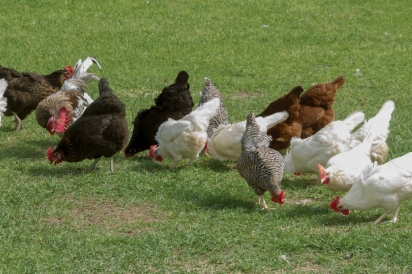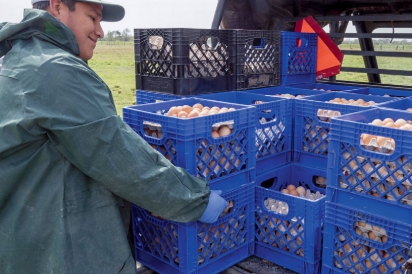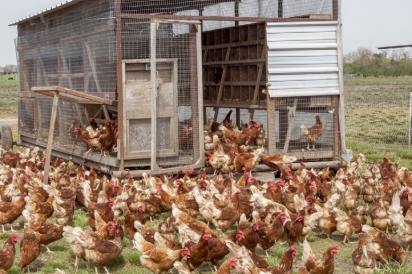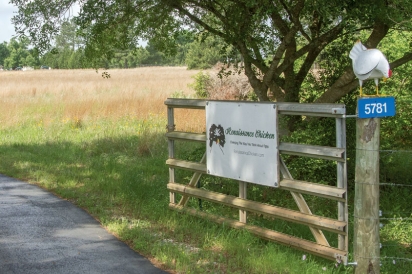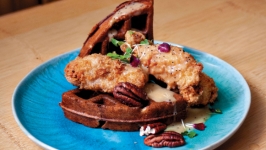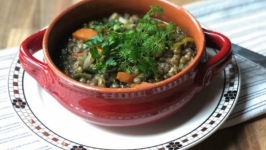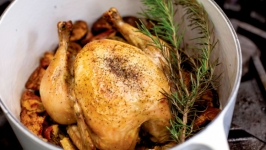Happy Chickens lay delicious eggs at Renaissance Chicken
Crack a pastured egg and a regular supermarket egg into a bowl and you may notice some differences. One that’s quickly apparent is the color of the yolks, which in pastured eggs come in shades of orange more vibrant than the whitish-yellow yolks of conventional varieties.
Pastured egg farmers and consumers will agree that pastured eggs are more flavorful. They’ve also been found to be more nutritious, containing higher levels of omega-3s, folate, folic acid and vitamins A and E and lower levels of cholesterol and saturated fat.
Egg farmers attribute these characteristics in the egg to how the birds laying them eat and live. Pastured chickens spend time outdoors, forage on grasses and bugs and get plenty of sunshine, fresh air and exercise.
Colorful Eggs
“My chickens are out there doing chicken things, living a natural chicken life, making a mess, messing with the garden,” says Camille Kenney, owner of Renaissance Chicken in Sealy, Texas, some 50 miles west of Houston.
What started as a part-time venture eight years ago has grown into a full-time endeavor for Kenney. She started the business with her boyfriend, Dennis Alexander, who owns the land, and a friend. First they had four hens, then eight. Soon, they were taking her eggs to small area farmers markets because they had more eggs than they could eat. Other vendors at the market sold eggs as a sideline to vegetables or other products, so many were skeptical that Kenney could make it selling just eggs, but she proved that customers were willing to pay $7 for a dozen.
“I think [people] like eggs and they want good eggs made available without animals being in a really bad situation,” says Kenney.
At Renaissance Chicken, named after Renaissance Center in Kenney’s native Detroit, chickens are free to graze, root, scratch and run around. They get a soy-free, non-GMO feed and are loved on by Kenney, who jokes that she’s running a chicken retirement home because she doesn’t like parting with the hens that have served her so well (she sells them as pets when their laying slows down).
Her flock of 2,000 is made up of common laying breeds—such as the white-feathered Leghorn, which lays white eggs, and the Production Red, a hybrid red hen that lays large brown eggs—and anywhere between 15 and 20 heritage breeds, as well as ducks and quail.
“I got into heritage [breeds] because of all the different colors. Eggs come in yellow, blue, dark chocolate, white, pink, green,” she says. “I thought they were just adorable; they’re just so pretty, so I try to do my boxes up with color.”
In her garage, which serves as an egg packaging and storage space, Kenney pulls out a wire basket filled with eggs in different shades. She saves the colorful eggs for the Urban Harvest Eastside Farmers Market, which she currently goes to every other week. She sells some 50 dozen eggs there, plus quail and duck eggs when she has them. She also makes weekly deliveries to area restaurants including Pondicheri, Ritual and Brenner’s On The Bayou.
Kenney’s business has grown steadily. In part, that’s why she got into the egg business. “I wanted something that I knew people would always buy,” she says. But she always feels like she could produce more. Alexander’s work now prevents him from helping her with the farm and markets, so Kenney is limited in how much she can supply, but she hopes that by hiring help and forming a collective of small egg farms to supply restaurants she can soon get her eggs into the hands of more people.
Happy “Girls”
Ken Adams of Kenz Henz in Santa Fe, a city in Galveston County, describes the nature of his egg business as either feast or famine. “I tell my wife, ‘We’re either going to have too many eggs or not enough eggs,’” says Adams. “Chickens don’t just lay; they don’t just say, ‘OK, Kenz Henz, I’m a chicken and I’m going to give you six eggs in a row, skip a day, for a year.”
Instead, pastured hens go through cycles. In extreme cold, the food they consume is used to produce energy and warmth instead of eggs, so production drops. They’ll start laying more eggs in the spring before phasing into summer, which Adams calls the worse time of year for his flock. The birds can’t get enough water, they pant and perspire and are generally hot and unhappy, which means they’re not producing a lot of eggs.
“It’s a cycle you have to learn when you do pastured hens,” said Adams. Unlike conventional hens that are kept in environments where the climate and light can be controlled, pastured hens are exposed to natural influences out of the farmer’s control.
A youth sports coach for nearly 40 years, Adams started raising chickens as a hobby that he began devoting more time to when he left sports. “It’s a hobby that went awry,” he says.
When he had more eggs than his family could eat, he started giving them to neighbors. Soon, people wanted to buy them, so he bought more chickens and started selling at farmers markets in Houston’s surrounding areas. In 2015, at the suggestion of his customers, he started selling his eggs to Arlan’s Market, a familyowned grocery store business based in Seabrook. Today Adams sells about 70,000 eggs per week to about 30 HEBs, a dozen Krogers and some specialty stores.
Adams no longer sells at farmers markets because he doesn’t have the resources to do so. But he still has a relationship with his customers, many of whom let him know via text or phone when they can’t find his eggs at their local stores. When asked how he maintains quality and sustainable practices as he grows, Adams has a simple answer: “We just maintain what we’re doing at the same scale and try to do better.”
An important part of his business is educating people about eggs. There is a lot of confusion about what egg labels such as “cage-free,” “free-range” and “pastured” really mean. Cage-free, for instance, means that chickens aren’t kept in cages but they can still be confined inside a building in a two-by-two-foot square without ever seeing the light of day. Buying them only supports the poor treatment of the animals.
“A lot of people just don’t realize what caged birds live through,” says Adams. “It’s hostile. No animal should have to do that to satisfy a human need.”
Adams’s 14,000 Hyline Brown hens live on 250 acres. The girls, as he refers to them, live in houses that he moves every seven to 10 days. Whenever the houses are moved to new pastures, the chickens get what Adams calls new salad bars: access to fresh grasses, bugs, weeds and flowers. It’s what he credits for the better flavor, creamier texture and quality of his eggs. Plus, moving the houses isn’t only good for the chickens. It also helps the land, which gets richer and healthier as the chickens cycle through it. Adams supplements the birds’ pasture diet with vegetarian feed and treats them as naturally as possible when they get sick—which isn’t often. He also genuinely enjoys being around them.
Says Adams, “When you take them and move them to a brand new pasture and open their door and listen to them coming out of the house, they know that they’re on a new pasture and they are happy. You can hear all different types of pitches in their voices; they’re talking to each other, they hit the ground, they’re running, they’re eating grasses. You can’t imagine what it does to your heart when you see the girls that happy.”
Despite their different business models, something Renaissance Chicken and Kenz Henz have in common is farmers who truly care about giving their birds a healthy, happy life. The proof is in the egg.
Aside from spending time with her family, Paula Niño Kehr loves to explore Houston and learn about the people behind its food.



